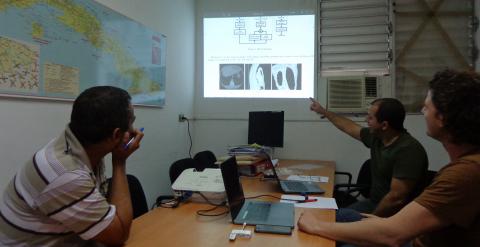
After an intense week of academic activities in which, for the first time, the progress of the first stage of the VLIR-IUC was shown. Dr. Jef Vandemeulebroucke completed several work sessions at the Universidad de Oriente, together with the project he manages for the Flemish side, focused on research and applications in the processing of biomedical images and signals.
"We think that one of the most important issues we are working on now is the automatic analysis of medical images. In the global industry and in Belgium, we see that this technology is very important. Right now, one of the pieces of research of the project is aimed at the detection of pulmonary nodules automatically. I believe that this is a fundamental line and that it has many possibilities in the Center for Medical Biophysics (CBM) and in the Neuroscience Studies Center, Image and Signal Processing (CENPIS), where two works are also carried out in this sense”.
Dr. Jef Vandemeulebroucke, professor at the Free University of Brussels (VUB) and specialist in image processing, points out that for the second stage there is a lot of future in the automatic diagnosis. "We have to work on this to give the same level of attention in the health system, and informatics can help. We have made considerable progress with some works but we still have to do more. "
For Vandemeulebroucke, the coordination of this project is his first work experience in Cuba. "In this first stage, the Belgian researchers have also learned a lot. This professional experience helps open your eyes and connect with other people in an easier way. "
While Jeff reviews the advances in the research of the young PhD. student Alexander Sóñora Mengana, directed to the detection of pulmonary nodules in images of Computed Axial Tomography, we also talked to Dr. Juan Carlos García Naranjo, Cuban leader of P2.
"The project is focused on biomedical technology - Naranjo explains -. It has three fundamental subprojects, one dedicated to magnetic resonance, another focused on the exploitation of images and signals and the final one aimed at the neuroprotective effect of magnetic fields. In these years of work, tools in the area of electroencephalography and cardiography, still in stages of testing but no doubt important, have been achieved".
At present, García Naranjo is the director of the Center for Medical Biophysics, a scientific institution devoted to research and development activity in the field of magnetic resonance and its biomedical applications. He proudly comments that today,the P2 also exhibits results linked to the neuroprotective effect of the magnetic field. "We have two theses that will be defended soon, one of them associated with the generation of blood vessels, which is already fully demonstrated. In the part that has to do with the MRI we have had results, which have been published in important science sites and tested in hospitals. For example, we have had an impact on Sicklemia studies. "
Vandemeulebroucke and García Naranjo seek to develop the specific purpose equipment in order to bring these tools to hospitals soon. "With the support of VLIR, the CBM obtained the permit as manufacturers of medical equipment for the IMAGIS and we are processing the special permission to market it. This is important because Imagis should serve us to bring all this software development to the hospital. "
At the end of the meeting, García said: "It is important all the work we have done with the universities that make up the Flemish Interuniversity Council. There are experiments that have been carried out there, because we do not have the equipment here, but conditions have also been created in Cuba. Two laboratories have been created, a specialized classroom for students of various specialties, including physics, chemistry, agronomy and mechanics, and we have also strengthened working relationships among us, for example with CENPIS ".
For Jeff, work in Cuba is very interesting. "I love being in Latin America. The 1stPhD Scientific Workshop has been very interesting because it is nice to see how much progress has been achieved in these five years. It has been hard, sometimes I did not have the certainty that everyone was going to achieve it. I am happy because the results are numerous and the level of the presentations has been great. I'm very proud of this team".
Translator: Lilia Sanz Gámez
Dr. Jeff Vandemeulebroucke and Dr. Juan Carlos García Naranjo work along with the young research Alexander Sóñora in a research focused on the detection of pulmonary nodules in images of Computed Axial Tomography.
Dr. Jef Vandemeulebroucke (right), professor of the Free University Brussels (VUB) and specialist in image processing acknowledges that there is a bright future for the automatic diagnosis.
Dr. Juan Carlos García Naranjo explains that research linked to the neuroprotective effect of the magnetic field and resonance are exhibited at present. Photos: Daylenis Blanco.

